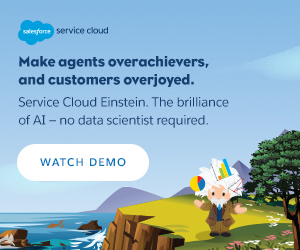This content was produced for Salesforce by the foundry @ MEREDITH CORP. FORTUNETM editorial staff was not involved in its creation or production.
To compete in the face of ongoing digital transformations, businesses are realizing just how critical a connected customer experience can be. Given the increasingly diverse customer demands and technology challenges, and the critical importance of supporting mobile-equipped field agents, this means modernizing IT departments to engage as many consumer touch points as possible.
 Photo: Getty Images
Photo: Getty Images
As more and more organizations focus on supporting an increasingly distributed workforce, it also means ensuring field service teams are connected internally and at every touch point along the customer journey. But while innovative technologies like the Internet of Things (IoT), big-data analytics, cloud services, and augmented reality are redefining go-to-market strategies, product offerings, and customer engagement, 77% of companies still deploy on-premise field service solutions, while 52% are using manual methods, such as spreadsheets and printouts, to handle field service tasks, according to a survey by Field Service News.
78% of field service professionals believe there will be significant competitive gains for companies that become early adopters of IoT as a field service tool.
Siloed internal departments and ineffective communication channels often inhibit cross-team collaboration and confuse customer interactions. The resulting duplicate efforts and inefficient resource allocation can lead to multiple service calls, protracted wait times, and unnecessary effort to resolve service issues. In many instances, such inefficiencies result in a substantial loss of business.
Understanding Digital Demands
Today’s consumers are digitally savvy and increasingly demanding. They expect simple, real-time solutions such as automated service reminders, personalized preferences, and online scheduling across a variety of different digital channels and devices. By harnessing these same capabilities, field service organizations gain not only a 360-degree view of their customers but also the ability to respond quickly and appropriately to customer inquiries.
The result is loyal repeat customers, as well as opportunities for field service agents to cross-sell and upsell new products and services. For instance, insights unlocked by data analytics can help agents anticipate customer needs and predict and deliver the right product at the right time, while advanced mobile platforms can help teams share information seamlessly to ensure every customer interaction adds value to the customer experience and customer relationship. And smart products can harness the power of IoT to proactively service products and serve consumers.
In fact, a recent survey by Field Service News found that 78% of field service professionals believe there will be significant competitive gains for companies that become early adopters of IoT as a field service tool. It also discovered a direct link between IoT adoption and a shift toward a more proactive approach to field service delivery.
Reconnecting to the Connected Consumer
New products can also become facilitators for companies to deliver advanced services. Servitization, the shift toward the prioritization of customer service in product development, is designed to unlock new revenue opportunities for businesses by applying consumer insights during the product development process.
Data collected from IoT-connected sensors can indicate the need for maintenance on certain smart devices. These products can proactively alert their manufacturers via wireless networks, and the manufacturer can then perform software updates or generate service requests. In the energy industry, smart meters can link to mobile workforce dispatching systems that automatically send maintenance crews to repair broken meters.
Connected technologies that inform and improve overall asset use, maintenance, and repair actions produce a ripple effect, particularly when consumer insights provided by data and analytics are integrated with an internal customer relationship management (CRM) system.
For example, on the customer side, combining data analytics with AI can help identify valuable consumer behaviors that can then be used to automate and customize consumer messaging and marketing strategies. AI-powered apps can also provide insights that help managers optimize their support teams.
On the product side, augmented reality in the form of smart glasses can instantly connect field technicians with internal R&D experts and engineers for onsite guidance and advice.
By tying both sides together, Salesforce is transforming field service by connecting teams and technologies, streamlining communications, and enabling organizations to create more seamless and efficient customer connections using a single, centralized CRM service platform.
Through the Salesforce Service Cloud, companies can effectively link customers with dispatchers and mobile employees, ensuring that data points generated in one department of an organization are updated globally and are instantly accessible from any mobile or desktop device, regardless of cell connectivity. Mobile employees can deliver smarter, faster, more personalized onsite service and have access to the tools and platforms they need to meet the needs of today’s connected customers—anytime, anywhere. And with the Salesforce Field Service Lightning solution, companies can connect their entire workforce to deliver speedy and intelligent onsite service.
By giving managers the insights they need to optimize their support teams, field service employees can become a more valuable part of the overall customer experience.
78% of field service professionals believe there will be significant competitive gains for companies that become early adopters of IoT as a field service tool.




